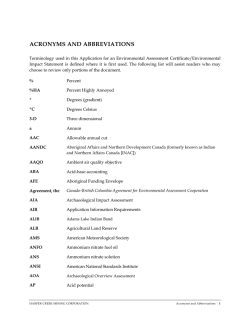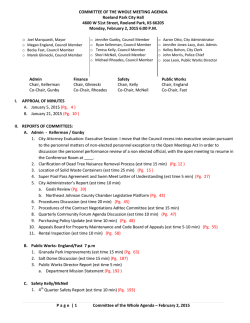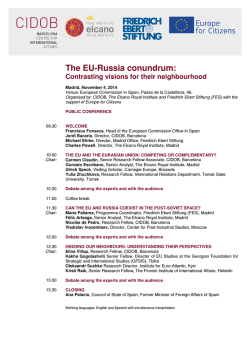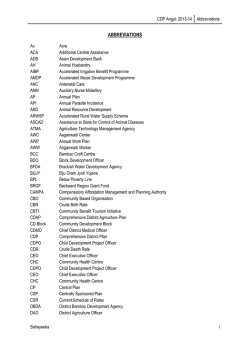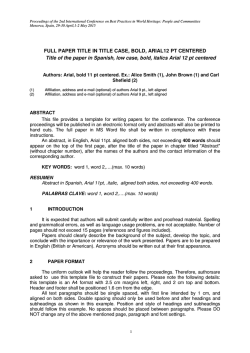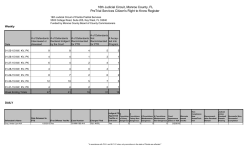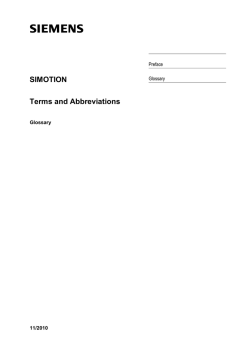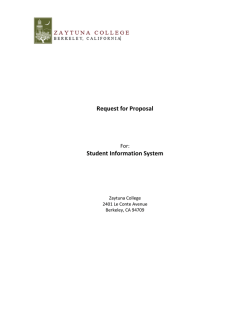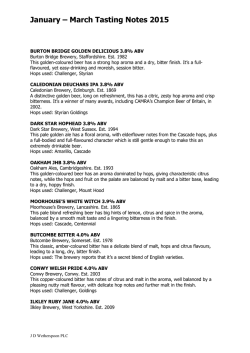
Estudios Bíblicos - Universidad Eclesiástica San Dámaso
Estudios Bíblicos Instructions for Contributors General Norms Articles submitted to Estudios Bíblicos are expected to conform to these instructions, before they are considered for publication. In case more detailed information is required, please see methodology notes of the Universidad San Dámaso or "Normas de estilo de Estudios Bíblicos": EstB 63 (Madrid 2005) 357-415. 1. Legal Conditions: In no case should articles that appear elsewhere or are available on line, in the same or a different language, be submitted to this journal. 2. Language: Estudios Bíblicos accepts contributions in Spanish, English, French, German, Italian and Portuguese. 3. Submission: Manuscripts will be sent as a Word file as well as a PDF version to the following e-mail address: [email protected]. 4. Manuscript Length: Contributions should conform to a text length approximately between 8000 and 12000 words (including footnotes). 5. Summary and Keywords: Articles should be accompanied by a summary of about 100 words followed by four to six keywords for indexing purposes. Both, summary and keywords, in Spanish and English. 6. Fonts: Manuscripts should be written in an Unicode font, for example, Times New Roman Unicode or TITUS Cyberbit Basic. 7. Non-latin characters: The use of Greek, Hebrew and Aramaic quotes must be limited to essential words to the exegetic discussion. Unpointed Hebrew or Aramaic should be used, unless the vocalization is crucial to the discussion. 8. Transliteration of Hebrew and Greek: We ask our contributors not to use any of the existing transliteration systems, except for conjectural isolated forms which are not present in the Bible or when it is necessary for the argumentation. In this case, use the system proposed by S. BAZYLIŃSKI, A Guide to Biblical research (Subsidia Biblica 36; Gregorian & Biblical Press, Roma 22009). 9. Figures, drawings, charts, diagrams: Photos and scanned images should be sent as a TIFF file and with a resolution of 300 ppp. Charts, diagrams and drawings with lines should be sent as an EPS or PDF file. 10. Subdivision: Text should not include more than three levels of subdivision. Roman numerals are to be used for numbering first level headings, arabic numerals for second level headings and alphabet for third level headings. I. First level headings 1. Second level headings a. Third level heading 11. Punctuation: Authors should use the quotation marks of the language in which the article is written (“...”; «...»; „...“), for both quoting and for referring to a word or a journal article. Contributors who write in Spanish should observe the RAE style punctuation to indicate quotations within quotations: « “ ‘ ... ’ ” ». English, French, German and Italian writers should observe the spelling rules of the language in which they have written, except in the point below. Punctuation marks come always after quotation marks and after footnote reference numbers, whatever the language in which the article is written — e.g.: “book”1; «libro»; „Buch“3; « livre ». 12. Aceptation and Publication: As soon as manuscripts have been considered for publication, aceptation or refusal will be explicitly communicated to authors. Before publication authors will receive a PDF version of the print proofs of their contributions in order to be corrected quickly. At this stage in the production process only minor corrections are allowed. A definitive PDF file of the article and twenty-five offprints will be supplied to authors of articles for personal use. Bibliographical references Book F. BELLI et al., Vetus in Novo. El recurso a la Escritura en el Nuevo Testamento (Madrid 2006). C. M. MARTINI – N. VENTURINI, Atti degli Apostoli (Venezia 1965) 8. Book in a Series L. F. HARTMANN – A. A. DI LELLA, The Book of Daniel (AB 23; Garden City, NY 1978) 212-213. F. GARCÍA LÓPEZ, El Pentateuco. Introducción a la lectura de los cinco primeros libros de la Biblia (IEB 3a; Verbo Divino, Estella 2003). Essay/Chapter in a collective Work P. RICOEUR, "Interpretative narrative", en: R. M. SCHWARTZ (ed.), The Book and the Text. The Bible and Literary Theory (Cambridge, MA 1990) 237-257. Multivolume Book L. ALONSO SCHÖKEL – J. L. SICRE DÍAZ, Profetas I. Jeremías (Madrid 21987) 112. K. BEYER, Die Aramäischen Texte von Toten Meer I (Göttingen 1984) 317, 348, 367; II (Göttingen 1994) 175, 180-181. Second and Later Book Editions R. BULTMANN, Das Evangelium des Johannes (Göttingen 101964) 518 n. 3. 2 Journal Article E. MENA SALAS, "Condiciones para una misión cristiana a los gentiles en el entorno sirio. El ejemplo de Antioquía": EstB 64 (2006) 163. Subsequent citations BELLI et al., Vetus in Novo, 15-16. MENA SALAS, "Condiciones para una misión", 163. Scripture Sources Lk 1,3-4.7-9; 4,3-6; 1 Co 5–7, Ga 3,1–4,5 Electronic Sources L. ALONSO, "Fe y ciencia" en: http://www.intereconomia.com/programa/informativos (7 enero 2006). Please note: There is a space between an author's initials. If there are two or three authors, they should be separated by an en-dash and spaces. When there are more than three authors, first author should be followed by et alii or et al., both in italics. There is no comma after the closing parenthesis following the date of a reference. The publisher, when it is mentioned, should be written between brackets, before the place of publication and followed by a comma. Once the full information for a book or article has been given, a shortened title is to be used in subsequent citations: family name of the author, keywords in the title and page number. Biblical abbreviations should be written in roman characters with no puntuation. A comma should be used between chapter and verse, a hyphen between verses and an en-dash to separate chapters. References to one or more verses of texts previously cited should use the form v. 1; vv. 2-4. General references to works previously cited, e.g., op. cit., art. cit., etc., must be avoided. Also f. or ff. (and equivalents) for "following" pages or verses. Full, inclusive pagination and verse references should be given. Abbreviations 1. General abbreviations: The commonest abreviations in the author´s language should be written in roman types (not italics): cf.; cap.; chap.; Kap.; e.g.; etc.; v.; vv., except Latin abbreviations, which should be written in italics: ibid.; ID.; et al.; et alii. 3 2. Abbreviations of names of journals, series, dictionaries and lexicons should be those given in S. SCHWERTNER, Internationales Abkürzungsverzeichnis für Theologie und Grenzgebiete (Berlin – New York 21992). 3. Primary Sources Abbreviations should be those proposed in P. H. ALEXANDER – J. F. KUTSKO – J. D. ERNEST – S. A. DECKER-LUCKE (eds), The SBL Handbook of Style. Abreviations of names of Dead Sea Scrolls and related texts should be those given in F. GARCÍA MARTÍNEZ (ed.), Textos de Qumrán (Madrid 1992). 4. Abbreviations of the names of biblical books should be those used in The New Jerusalem Bible, which are listed in the following table. OldTestamentAbbreviations English Gn Ex Lv Nb Dt Jos Jg Rt 1-2 S 1-2 K 1-2 Ch Ezr Ne Tb Jdt Est 1-2 M Jb Ps Pr Qo Sg Ws Si Is Jr Lm Ba Ezk Dn Ho Jl Am Ob Jon Mi Na Hab Zp Hg Zc Ml French Gn Ex Lv Nb Dt Jos Jg Rt 1-2 S 1-2 R 1-2 Ch Esd Ne Tb Jdt Est 1-2 M Jb Ps Pr Qo Ct Sg Si Is Jr Lm Ba Ez Dn Os Jl Am Ab Jon Mi Na Ha So Ag Za Ml German Gen Ex Lev Num Dtn Jos Ri Rut 1-2 Sam 1-2 Kön 1-2 Chr Esra Neh Tob Jdt Est 1-2 Makk Ijob Ps Spr Koh Hld Weish Sir Jes Jer Klgl Bar Ez Dan Hos Joël Am Obd Jona Mi Nah Hab Zef Hag Sach Mal Spanish Gn Ex Lv Nm Dt Jos Jc Rt 1-2 S 1-2 R 1-2 Cro Esd Ne Tb Jdt Est 1-2 M Job Sal Pr Qo Ct Sb Si Is Jr Lm Ba Ez Dn Os Jl Am Ab Jon Mi Na Ha So Ag Za Ml 4 Italian Gn Es Lv Nm Dt Gs Gdc Rt 1-2 Sam 1-2 Re 1-2 Cr Esd Ne Tb Gdt Est 1-2 Mac Gb Sal Pr Qo Ct Sap Sir Is Ger Lam Bar Ez Dn Os Gl Am Abd Gn Mi Na Ab Sof Ag Zc Ml NewTestamentAbbreviations English Mt Mk Lk Jn Ac Rm 1-2 Co Ga Ep Ph Col 1-2 Th 1-2 Tm Tt Phm Heb Jm 1-2 P 1-2-3 Jn Jude Rv French Mt Mc Lc Jn Ac Rm 1-2 Co Ga Ep Ph Col 1-2 Th 1-2 Tm Tt Phm He Jc 1-2 P 1-2-3 Jn Jude Ap German Mt Mk Lk Joh Apg Röm 1-2 Kor Gal Eph Phil Kol 1-2 Thess 1-2 Tim Tit Phlm Hebr Jak 1-2 Petr 1-2-3 Joh Jud Offb Spanish Mt Mc Lc Jn Hch Rm 1-2 Co Ga Ef Flp Col 1-2 Ts 1-2 Tm Tt Flm Hb St 1-2 P 1-2-3 Jn Judas Ap 5 Italian Mt Mc Lc Gv At Rm 1-2 Cor Gal Ef Fil Col 1-2 Ts 1-2 Tm Tt Fm Eb Gc 1-2 Pt 1-2-3 Gv Gd Ap
© Copyright 2024

